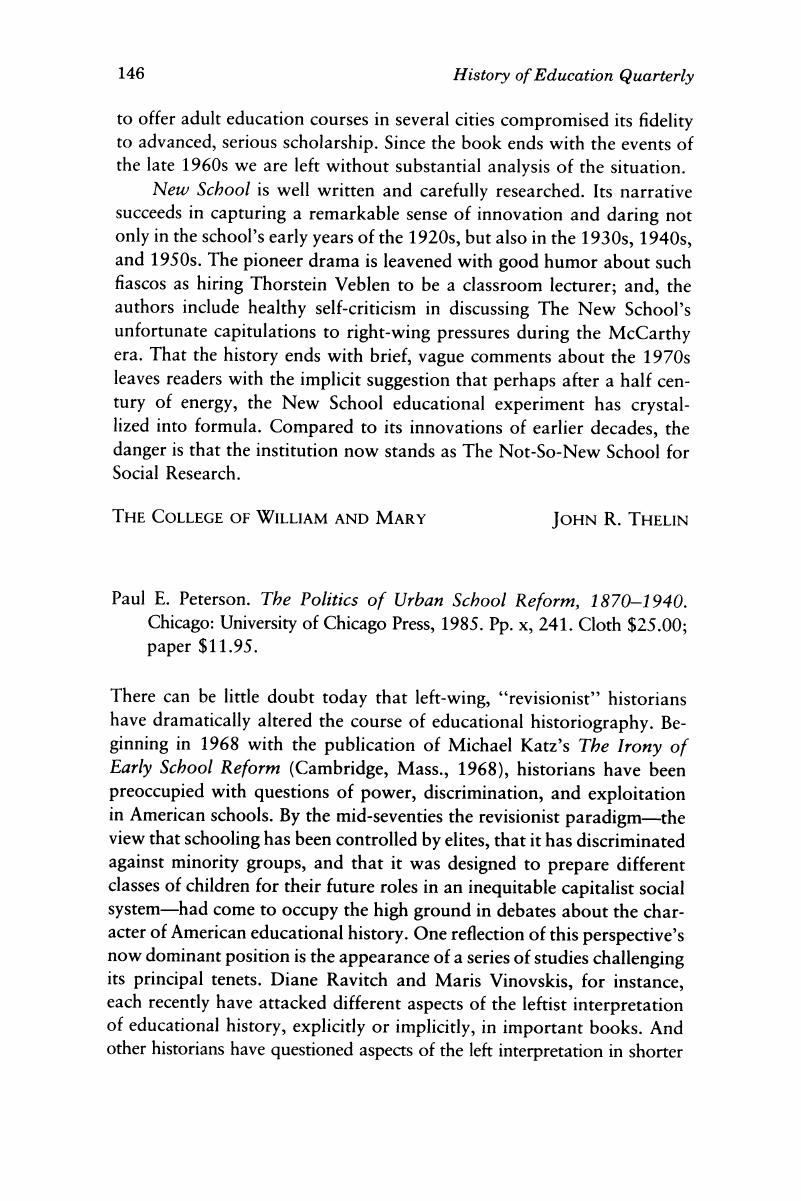No CrossRef data available.
Published online by Cambridge University Press: 24 February 2017

1. Ravitch, Diane, The Troubled Crusade: American Education, 1945–1980 (New York, 1983); and Vinovskis, Maris A., The Origins of Public High Schools: A Reexamination of the Beverly High School Controversy (Madison, Wis., 1985). See the discussion of Ravitch's work by Katz, Michael in History of Education Quarterly 25 (Spring-Summer 1985): 175–80. Also see Berman, Barbara, “Business Efficiency, American Schooling, and the Public School Superintendency: A Reconsideration of the Callahan Thesis,” History of Education Quarterly 23 (Fall 1983): 297–322.Google Scholar
2. It is proper to say “Peterson and associates” because in the book's acknowledgements Peterson claims to be the principal author of only four of the book's nine chapters, though he bears “responsibility for determining what was to be included and for the analysis and interpretation of the data in each chapter” (p. ix). Co-authors, whose names do not appear on the title page, include Peterson, Carol Weir, Margaret Christiansen, James Echeverri-Ghent, John Turner-Jones, Marcia Plank, David, and Ginsberg, Rick.Google Scholar
3. See, for instance, West, E. G., Education and the State: A Study in Political Economy (London, 1970); or, more recently, Murray, Charles, Losing Ground: American Social Policy, 1950–1980 (New York, 1984), ch. 13.Google Scholar
4. Peterson also cites Bowles, Samuel and Gintis, Herbert in this connection, but chooses a quote from Schooling in Capitalist America which explicitly concerns the present, rather than the period under discussion.Google Scholar
5. See Dubofsky, Melvyn, Industrialism and the American Worker, 1865–1920 (Arlington Heights, Ill., 1975), 84–95. On the great diversity in American workers in this period, see Gutman's, Herbert G. classic essay, “Work, Culture, and Society in Industrializing America, 1815–1919,” American Historical Review 78 (June 1973): 531–88.Google Scholar
6. Thernstrom, Stephan, The Other Bostonians: Poverty and Progress in the American Metropolis, 1880–1970 (Cambridge, Mass., 1973), ch. 6.Google Scholar
7. On the concept of hegemony, see Jackson Lears, T. J., “The Concept of Cultural Hegemony: Problems and Possibilities,” American Historical Review 90 (June 1985): 567–93. One reason Peterson does not employ a more sophisticated critique of leftist educational history may be that he simply does not consider several important historians whose work has dealt with this period and who are generally included in the “revisionist” school. None of the works of Clarence Karier, Joel Spring, or Paul Violas are even cited in his bibliography.Google Scholar
8. Callahan, Raymond, Education and the Cult of Efficiency: A Study of the Social Forces That Have Shaped the Administration of the Public Schools (Chicago, 1962), ch. 1.Google Scholar
9. See Hofstader, Richard, The Age of Reform: From Bryan to F.D.R. (New York, 1956); and Weibe, Robert, The Search for Order (New York, 1967).Google Scholar
10. Hogan, David John, Class and Reform: School and Society in Chicago, 1880–1930 (Philadelphia, 1985), ch. 6.Google Scholar